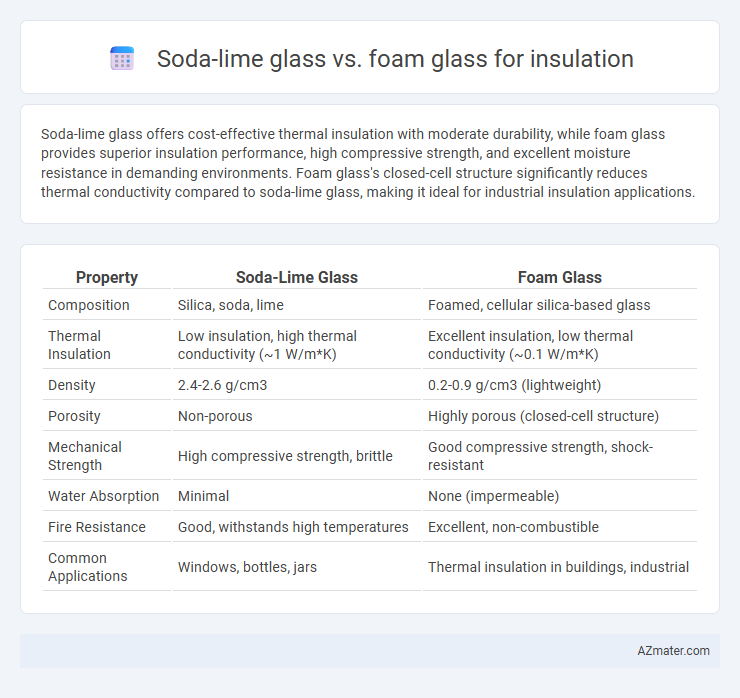Soda-lime glass offers cost-effective thermal insulation with moderate durability, while foam glass provides superior insulation performance, high compressive strength, and excellent moisture resistance in demanding environments. Foam glass's closed-cell structure significantly reduces thermal conductivity compared to soda-lime glass, making it ideal for industrial insulation applications.
Table of Comparison
| Property | Soda-Lime Glass | Foam Glass |
|---|---|---|
| Composition | Silica, soda, lime | Foamed, cellular silica-based glass |
| Thermal Insulation | Low insulation, high thermal conductivity (~1 W/m*K) | Excellent insulation, low thermal conductivity (~0.1 W/m*K) |
| Density | 2.4-2.6 g/cm3 | 0.2-0.9 g/cm3 (lightweight) |
| Porosity | Non-porous | Highly porous (closed-cell structure) |
| Mechanical Strength | High compressive strength, brittle | Good compressive strength, shock-resistant |
| Water Absorption | Minimal | None (impermeable) |
| Fire Resistance | Good, withstands high temperatures | Excellent, non-combustible |
| Common Applications | Windows, bottles, jars | Thermal insulation in buildings, industrial |
Introduction to Glass Insulation Materials
Soda-lime glass and foam glass serve distinct roles in insulation, with soda-lime glass primarily used in window panes due to its transparency and moderate thermal properties. Foam glass, a porous, lightweight material made from recycled glass, offers superior thermal insulation and moisture resistance, ideal for industrial and building applications. Both materials capitalize on glass's inherent stability and durability but differ significantly in structure and insulating performance.
Composition: Soda-Lime Glass vs Foam Glass
Soda-lime glass primarily consists of silica (SiO2), sodium oxide (Na2O), and calcium oxide (CaO), which give it a stable and durable structure commonly used in windows and containers. Foam glass, derived from crushed soda-lime glass mixed with a foaming agent like carbon, features a porous structure achieved through heating that creates lightweight, insulating foam. The composition of foam glass retains the chemical stability of soda-lime glass while enhancing thermal insulation properties due to its cellular, closed-porosity network.
Manufacturing Process Differences
Soda-lime glass insulation is produced by melting raw materials like sand, soda ash, and limestone at high temperatures, followed by forming and annealing into solid sheets or fibers. Foam glass insulation involves finely crushing glass, mixing it with a foaming agent, and heating it to create a cellular structure with trapped gas bubbles, resulting in lightweight, rigid panels. The key manufacturing difference lies in soda-lime glass's melting and forming process versus foam glass's foaming and expansion technique, which significantly affects thermal properties and mechanical strength.
Thermal Insulation Performance
Foam glass exhibits superior thermal insulation performance compared to soda-lime glass due to its closed-cell structure, which significantly reduces heat transfer through conduction and convection. While soda-lime glass is primarily used for windows and containers with moderate insulating properties, foam glass provides a much lower thermal conductivity, typically around 0.04 W/m*K, making it ideal for high-performance insulation applications. Its resistance to moisture and fire further enhances the durability and efficiency of foam glass as an insulating material.
Mechanical Strength Comparison
Soda-lime glass exhibits moderate mechanical strength suitable for general applications, with compressive strengths typically around 50-100 MPa. Foam glass, composed of crushed glass and expanded with gas bubbles, offers enhanced mechanical strength ranging from 1 to 7 MPa in compressive stress but excels in stiffness-to-weight ratio due to its cellular structure. While soda-lime glass provides higher absolute strength, foam glass delivers better impact resistance and durability under cyclic loading, making it preferable for insulation requiring mechanical resilience and thermal performance.
Moisture and Chemical Resistance
Foam glass offers superior moisture resistance compared to soda-lime glass due to its closed-cell structure, making it highly impermeable to water and vapor. Unlike soda-lime glass, which can absorb moisture and degrade over time in humid environments, foam glass maintains its insulating properties without chemical degradation. Chemical resistance in foam glass is also more robust, as it withstands acids, alkalis, and other industrial chemicals better than the more reactive soda-lime glass.
Fire Resistance Properties
Soda-lime glass exhibits limited fire resistance, softening at temperatures around 600degC and melting near 1400degC, which restricts its effectiveness in high-temperature insulation applications. Foam glass, composed of crushed glass with closed-cell structure, offers superior fire resistance due to its non-combustible nature and ability to withstand temperatures above 1000degC without deformation. This makes foam glass an optimal choice for insulation in environments where enhanced fire protection and thermal stability are critical.
Environmental Impact and Sustainability
Soda-lime glass requires higher energy consumption during production due to its high melting point, resulting in greater carbon emissions compared to foam glass, which often incorporates recycled glass and uses less energy in manufacturing. Foam glass insulation offers superior sustainability benefits by utilizing up to 90% recycled content and providing excellent thermal insulation that reduces energy consumption in buildings. The closed-cell structure of foam glass also ensures durability and resistance to moisture, minimizing material waste and extending product life cycles, making it a more environmentally responsible choice.
Cost Comparison and Economic Viability
Soda-lime glass insulation typically offers lower upfront costs compared to foam glass, making it more budget-friendly for large-scale construction projects. Foam glass insulation, despite higher initial expenses, provides superior durability, moisture resistance, and long-term energy savings, which can enhance economic viability in applications subjected to harsh environmental conditions. Evaluating the total cost of ownership, foam glass often becomes more cost-effective over time due to reduced maintenance and improved insulation performance.
Applications in Modern Construction
Soda-lime glass is widely used in modern construction for window glazing and architectural facades due to its transparency, durability, and cost-effectiveness, providing natural light while offering moderate insulation properties. Foam glass excels in thermal insulation and moisture resistance, making it ideal for building envelopes, roofing insulation, and foundation waterproofing in energy-efficient and sustainable constructions. The choice between soda-lime glass and foam glass depends on specific application requirements such as visibility, insulation performance, and structural integration in contemporary buildings.

Infographic: Soda-lime glass vs Foam glass for Insulation
 azmater.com
azmater.com